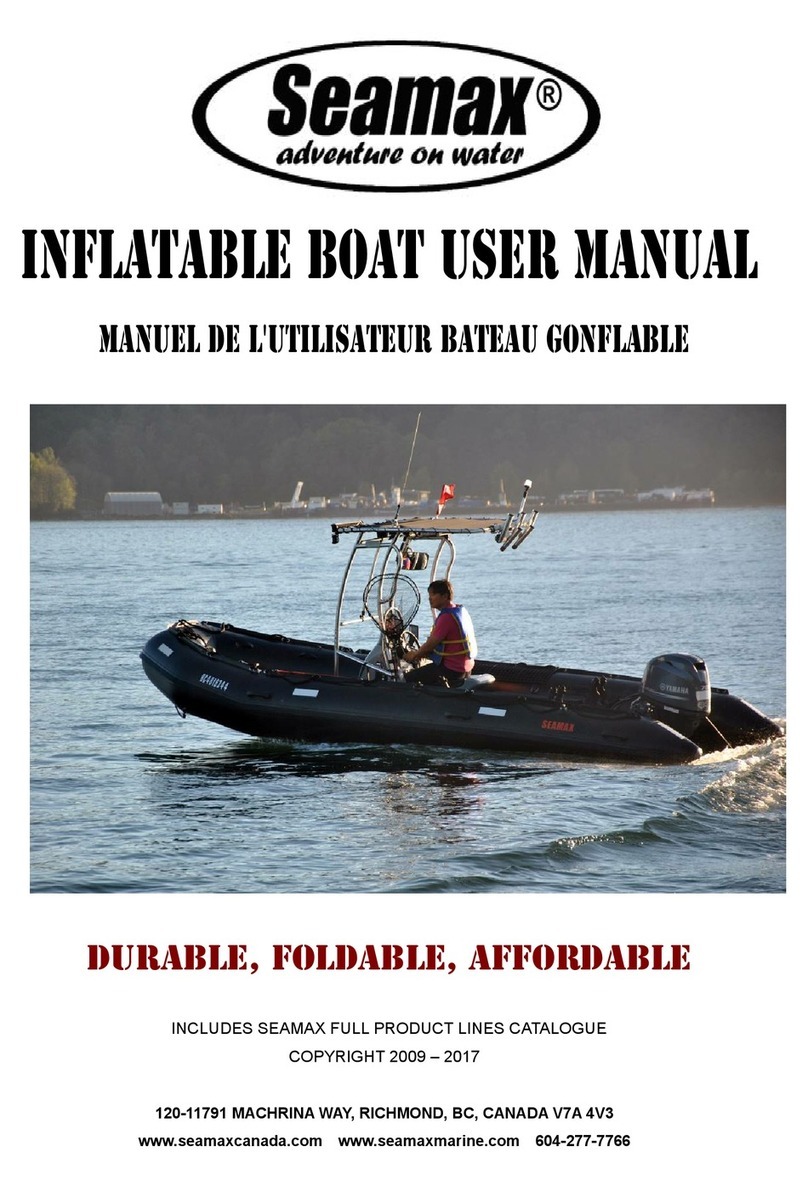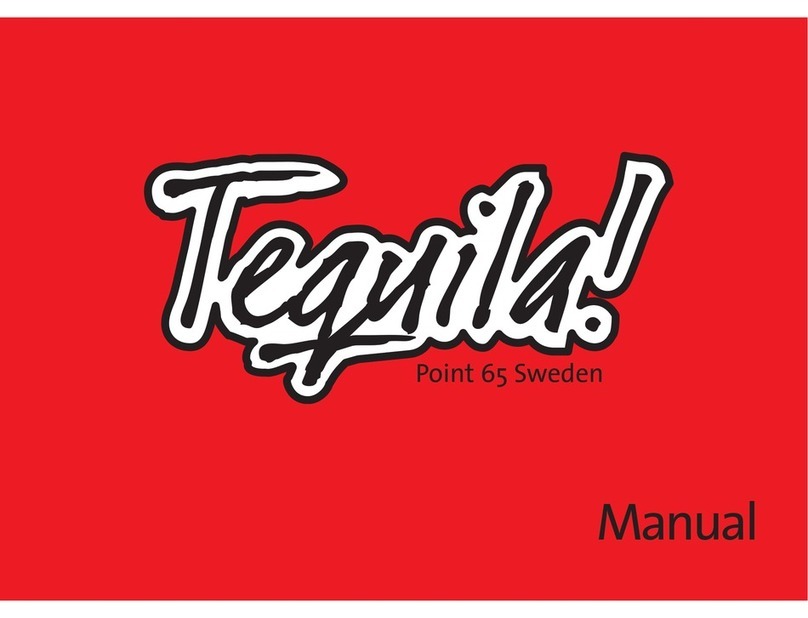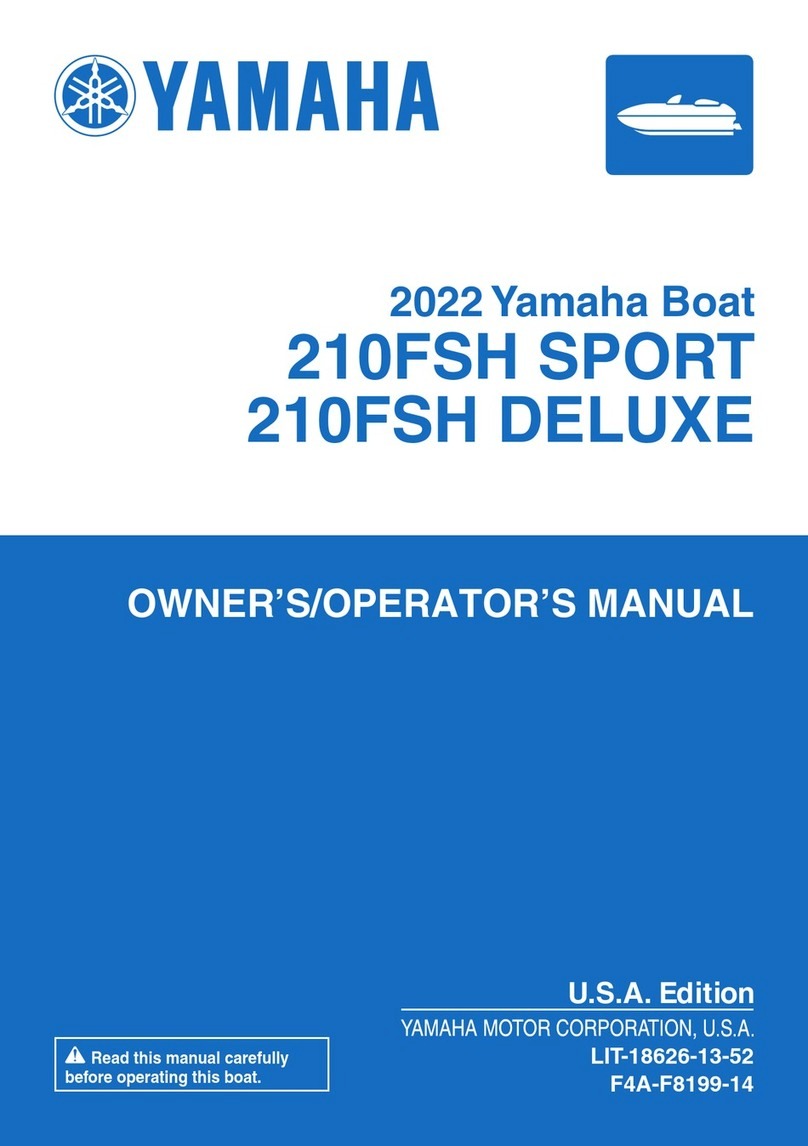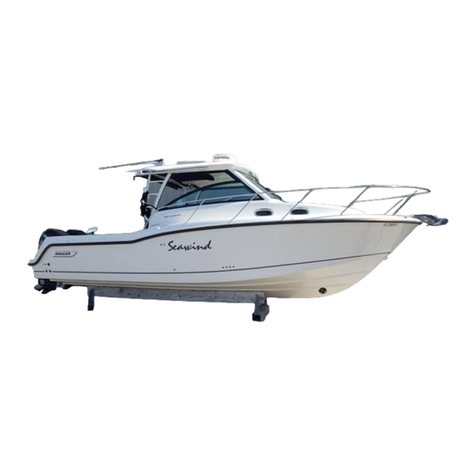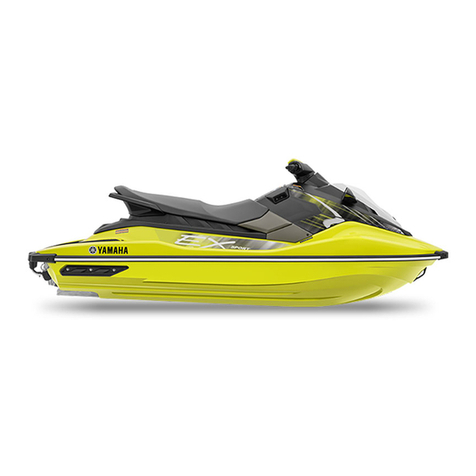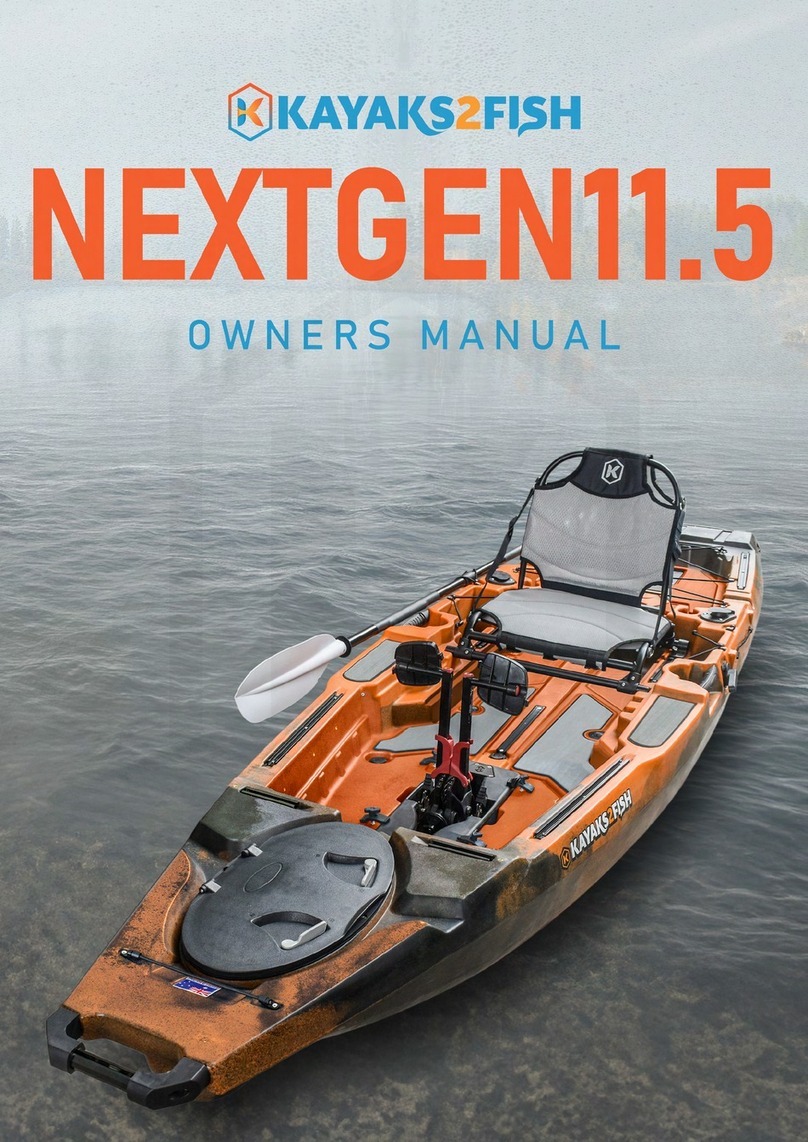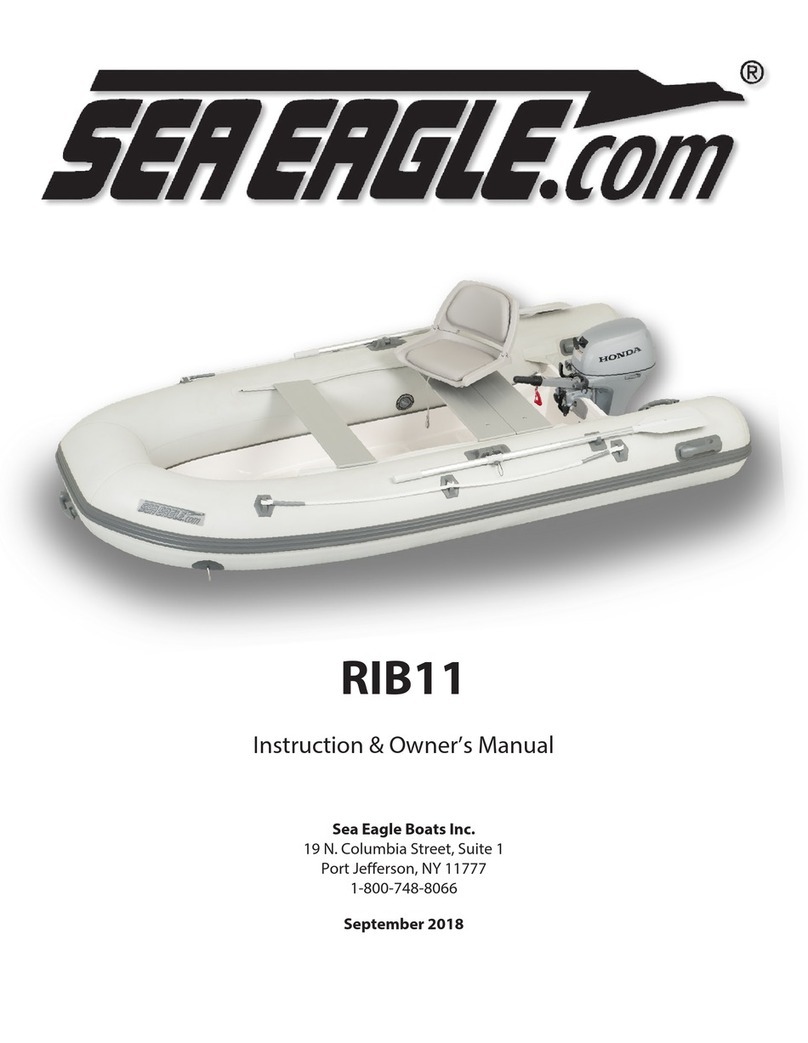HISON CROSSKI User manual

HISON WATERCRAFT
CROSSKI
Owner’s Manual

HISON WATERCRAFT
Welcome to our Hison Amphibious Space:
We are proud to announce our new product of year 2015, is this amphibian Crosski. It
will be a water transformer which is totally under your control.
△
!WARNING
Please read this manual as it contains important safety and
operating information
Never allow anyone under 16 years old to ride this Crosski.
All rights reserved by Hison. Information contained in this document is based on the latest
information available at the time of printing and is subject to the copyright and other intellectual
property rights of Hison Watercraft. No part of this document may be reproduced, stored in a
retrieval system, or transmitted in any form or by any means, electronic, mechanical,
photocopying, or otherwise. These materials must not be modified or reposted to other sites
without the prior expressed written permission of the copyright holder.

HISON WATERCRAFT
Table of contents
1. Fueling............................................................................. 4
2. Controls ........................................................................... 6
3. New Crosski Break-in ....................................................... 9
4. Planning a Safe Trip.........................................................10
5. Safe Operation on Land ...................................................14
6. Entering and Exiting the Water ........................................20
7. Maintenance Requirements ............................................30

HISON WATERCRAFT
1
About this Owner’s Manual
This Owner’s Manual contains a great deal of information about your amphibian Crosski. We
advise you to read it carefully and familiarize yourself with the controls before riding.
For your own safety, follow the instructions and warnings contained in this Manual. Ignoring
them could result in damage to the Crosski or personal injury to you or others. Damage caused by
failure to follow instructions is not covered by the Warranty Policy.
This Manual is printed on waterproof paper so that it can be well stored in the Crosski and
be available for reference if required. Should you resell your Crosski, remember to pass on this
Manual to the next owner.
Signal words and Symbols in the Manual
The following signal words and symbols are used in the Manual to designate safety
messages and other important information.
△
!WARNING indicates a hazardous situation which, if not avoided, could result in
serious injury or death.
△
!CAUTION indicates a hazardous situation which, if not avoided, could result in
minor or moderate injury.
NOTICE: not related to physical injury, or to prevent possible damage to the Crosski.

HISON WATERCRAFT
2
To Operator/Owner
Training
△
!WARNING
The Crosski is not a toy and can be hazardous to operate. Disregarding any of the safety
precautions and instructions contained in this Owner’s Manual or on the safety labels
attached to the Crosski could cause injury including the possibility of death!
Please read this Owner’s Manual and familiarize yourself with the Crosski before operating.
Observe the instructions o all safety labels. They are there to help you safely enjoy the use of
your Crosski.
The handling characteristics and performance of the Crosski on land and water may be
different than other ATVs and watercraft you have used. Please take the time to practice
maneuvers in a safe environment even if you consider yourself as an experienced rider.
Never use Crosski unless you have received proper training or instruction. Hison highly
recommends that you take an ATV rider safety course and a safe boating course. Please check
with a Hison Dealer or local authorities or availability in your area.
In certain areas, an operator competency card is mandatory to operate the Crosski on water.
Completion of an ATV rider safety course is also mandatory before operation in some areas.
Ensure that you are familiar with local laws and regulations concerning the off-road riding
areas and waterways that you are intending to use.
Age and Ability
Never allow anyone under the age of 16 to operate the Crosski.
Laws regarding the minimum age and licensing requirements of operators may vary from
one area to another. Be sure to contact the local authorities for information regarding the legal
operation of the Crosski for your area.
Do not allow a person to operate the Crosski if they have an impairment that may prevent
them operating it safely, for example, impaired judgment, vision, reaction time or the ability to
operate the controls. This includes temporary impairments such as fatigue.
Only attempt maneuvers and ride in situations that are suitable for your level of riding
ability and experience. Maneuvers or situations that are too challenging increase the risk of an
accident.
No alcohol or drugs
Never operate your Crosski under the influence of alcohol or drugs, including medications
that affect your ability to operate motor vehicles.
Like driving a car, driving the Crosski requires the rider to be sober, attentive and alert.
Operating the Crosski while intoxicated or under the influence of drugs is not only

HISON WATERCRAFT
3
dangerous, but also illegal.
The use of drugs and alcohol decreases reaction time, impedes judgment, impairs vision,
impacts balance and perception which could inhibit your ability to safely operate the Crosski.
No Passengers
Never carry passengers. The Crosski is designed for use by the rider only.
The additional weight of a passenger will affect the Crosski’s stability and maneuverability,
which will increase the chance of you losing control.
Note: The long seat is designed to allow the ride to change body positions while riding.
Important Safety Information
Avoid carbon monoxide poisoning.
Engine exhaust fumes contain carbon monoxide, a deadly gas. Breathing carbon monoxide
can cause headaches, dizziness, drowsiness, nausea, confusion and eventually death.
Carbon monoxide is a colorless, odorless, tasteless gas that may be present even if you do
not see or smell any engine exhaust. Deadly levels of carbon monoxide can collect rapidly, and
you can quickly be overcome and unable to save yourself. Also, deadly levels of carbon monoxide
can linger for hours or days in enclosed or poorly ventilated areas. If you experience any
symptoms of carbon monoxide poisoning, leave the area immediately, get fresh air and seek
medical treatment.
To prevent serious injury or death from carbon monoxide:
Never run the vehicle in poorly ventilated or partially enclosed areas such as garages,
carports or barns. Even if you try to ventilate engine exhaust fumes with fans or open
windows and doors, carbon monoxide can rapidly reach dangerous levels.
Never run the vehicle outdoors where engine exhaust fumes can be drawn into a nearby
building through openings such as windows and doors.
Never stand behind the Crosski while the engine is running. A person standing behind a
running Crosski may inhale high concentrations of exhaust fumes.
Accessories and Modifications
The installation of non-approved parts and accessories, or any non-approved modification to
your Crosski, may be dangerous and could affect the handling of the Crosski and the safety of the
rider. It may also invalidate the terms and conditions of the Warranty Policy.
It is extremely hazardous to fit parts or accessories where installation requires the
dismantling of, or addition to, either the electrical or fuel systems.
Consult a Hison Dealer before installing any parts or accessories and before making any
modification to the Crosski.
Safety Labels
Read the safety label before operating and always observe all instructions on the labels. If
any label is missing or damaged, please contact a Hison dealer to have the label replaced.

HISON WATERCRAFT
4
1. Fueling
Fuel Safety
△
!WARNING
Gasoline vapors are highly flammable, have a low flash point and are explosive, especially
in confined spaces. Avoid exposing the vapors to any potential sources of ignition as the
resulting fire and explosion may cause serious injuries and/or death.
Switch off the engine when refueling, as it is both a source of extreme temperatures and
electrical sparks. Failure to do so may cause a fire or explosion.
Do not smoke, use an open flame or cause sparks while refueling. The resulting fire and/or
explosion may cause serious injury or death.
Only use containers specifically designed for carrying fuel, failure to do so may result in
spillage and cause a fire.
Do not overfill the fuel tank. Overfilling may cause spillage when the Crosski is driven.
Spillage may also occur if the fuel expands in high ambient temperatures.
Do not start the Crosski if spilled gasoline or gasoline vapor is present.
Fuel Specification
NOTICE: Leaded fuels, lead substitutes or fuel additives, these can cause damage to the engine,
fuel and emission control systems.
In addition:
Fuel system cleaning agents should not be used as they may be harmful to fuel system
components on your vehicle.
If the fuel tank is filled with the wrong type of fuel, do not start the engine. It is essential
that you seek qualified assistance. Running the engine can cause serious engine and fuel
system damage.
Never use fuel containing more than 10% ethanol or methanol. The use of a
non-recommended fuel can result in decreased engine performance and damage to critical
parts in the fuel system and engine.
Only use a premium unleaded fuel.
Note: Even a very small quantity of leaded fuel will damage your vehicle’s emission control
system and could invalidate the emissions warranty.
Fuel tank capacity
NOTICE: Cause damage to the vehicle’s engine, fuel pump and emission control systems.
Total tank capacity: 60 Liters
Fueling Procedure:

HISON WATERCRAFT
5
△
!WARNING
In warm temperatures the fuel tank may be pressurized, take care when removing the filler cap
as fuel vapors may be released.
NOTICE:
Recommended: if possible always refuel on land. With the Crosski stationary and the engine off,
slowly unscrew the fuel filler cap and allow the vapors to vent.
Note: A chain secures the fuel filler cap to the Crosski to prevent loss.
The filler tube accepts a narrow filler nozzle of the type found on pumps that deliver
unleaded fuel.
Fill the tank slowly until the filler nozzle cuts off the fuel supply. Do not attempt to fill the
tank beyond this point, or spillage could result due to expansion of the fuel.
When replacing the fuel filler cap, insert the retaining chain into the filler neck and tighten
the cap until it clicks three times.
Emergency Refueling
△
!WARNING
It is possible to overfill the tank if a fuel dispensing pump is not used (e.g. portable fuel
containers).
If, in an emergency, you have to refuel the Crosski from a source other than a filling station,
check the specification of the fuel before refueling, and be careful not to overfill.
ATTENTION: If you do have to refuel while on water, make every effort to avoid fuel spillage. Fuel
can be very damaging to a marine environment.

HISON WATERCRAFT
6
2. Controls
Steering
△
!WARNING
To avoid pinching body parts, never turn the handlebars while someone is near the jet thrust
nozzle.
The handlebars control the direction of the Crosski when it is being operated on LAND and
WATER.
On land, the handlebars turn the front wheels for direction required.
Note: the jet nozzle also moves (in the opposite direction to the wheels) when turning on land.
On water, the handlebars move the het thrust nozzle to direct the water output in the
direction that you want to turn the Crosski.
Note: When operating in reverse, you will need to turn the handlebars in the opposite direction
to the direction you want to travel.
Ignition Switch
△
!WARNING
Do not turn the ignition switch to the ‘Lock’position while the Crosski is in motion –the
steering lock will engage, making it impossible to steer the Crosski.
Lock: Turn the handlebars all the way to the left or right then turn the key counterclockwise
to engage the steering head lock. No electrical circuits function.
Off: No electrical circuits function.
On: Turn the key fully clockwise to the ‘On’position. The Crosski powers up and the
instrument cluster illuminates.
Starting the Engine
△
!WARNING
Never start or leave the engine running in an unventilated building –exhaust gases
contain carbon monoxide, which can cause unconsciousness and may even be fatal.
Gasoline vapors can explode. Before starting the engine, operate the ventilation blower
for 4 minutes by turning the ignition key to the ON position. Remove the seat and check
the engine compartment for gasoline vapors.
Never operate the Crosski if the battery does not have sufficient power to start the engine
or shows other signs of decreased power (for example, long or slow engine cranking). Loss
of battery power when riding could leave you stranded.

HISON WATERCRAFT
7
To start the engine:
1. Insert the key in the ignition switch and turn the key to the ON position. A buzzer will briefly
sound to indicate that the ignition is ON.
2. Check that the steering column lock has disengaged by moving the handlebars from left to
right.
3. Make sure the engine safety cut-off is inserted under the engine off button and that the
lanyard is secured to your wrist or your personal flotation device (PFD). If the rider falls off
the Crosski, the engine will stop when the safety cut-off is removed.
4. Make sure the throttle lever is not pressed.
5. When on land, apply and hold the brake levers.
6. Press and hold the engine start button until the engine is running.
7. Release the start button once the engine has started.
△
!WARNING
When the engine is started, gear 1 is automatically selected. Do not rev the engine when
the Crosski is stationary.
The het impeller runs whenever the engine speed exceeds 2000 rpm irrespective of
whether the Crosski is on land or water. Keep others away from the intake grate and jet
nozzle when the engine is running.
Note: In cold conditions, the engine start time will increase.
Engine Stop/Cut-off
△
!WARNING
To maintain directional control on water, the engine must be running.
To stop the engine, press and hold the engine stop button or turn the ignition key to the off
position.
Alternatively, if the engine safety cut-off is pulled from under the engine stop button, the button
will retract toward the handlebar and the engine will stop.
To reinstall the engine safety cut-off, insert the cut-off between the engine stop button and the
handlebar.
Throttle Lever
The throttle lever on the right handlebar controls the speed of the Crosski when it is being
operated on both land and water.
To increase or maintain the speed of the Crosski Crosski, press on the throttle lever with
your thumb.
To decrease the Crosski’s speed, release the throttle lever.

HISON WATERCRAFT
8
Always use smooth transitions between throttle positions as sudden acceleration and
deceleration may upset the handling of the Crosski.
Note: The throttle lever is spring loaded and should return to rest position (engine idle) when not
pressed.
Braking (Land Mode Only)
Your Crosski is equipped with hydraulically operated brake calipers and rotors on each wheel.
Dependent upon specification, your Crosski, will either be equipped with a single brake lever that
operates the brakes for all four wheels, or dual brake levers that operate the brakes for the front
and rear wheels independently.
Apply the brake levers smoothly with increasing pressure to slow or stop the Crosski.
Note: remember, the brake levers will only slow or stop the Crosski when it is being ridden on
land and has no effect when the Crosski is being used on water.
Parking Brake (Land Mode Only)
△
!WARNING
Do not ride with the parking brake applied, or apply the parking brake while moving; this could
result in loss of control and may damage the brakes.
The brake levers have a parking brake feature that allow the Crosski to be left unattended with
the brakes applied.
To apply the parking brake:
1. Squeeze the brake lever
2. Push the parking brake lock into position
3. Release the brake lever while holding the lock in position
4. If your Crosski has dual brake levers, apply the parking brake on the other brake lever.
NOTICE: It can vary depending on brake pad wear. Make sure the parking brake is fully applied to
secure the Crosski in place.

HISON WATERCRAFT
9
3. New Crosski Break-in
Long-run if you perform the following guidelines:
1. Start the Crosski and let the engine warm up at idle for approximately 5-10 minutes.
2. Throttle at a moderate to fast idle below 2000 RPM for 10 minutes.
3. Ride the Crosski using various engine speeds.
Engine running procedure (first 10 hours)
Do not exceed 50% sustained throttle opening for the first five hours of engine running, and
75% throttle opening for next five hours.
Vary engine speed regularly during this time, and brief 5-10 second periods of acceleration
are permitted for getting on plane and to change speed.
Do not labor or overload engine.
Include at least two hours water running in the 10 hours.
Note: After the first 10 hours of running, the air cleaner should be checked and the oil filter
replaced.
Pre-ride Inspection
△
!WARNING
Always perform a pre-ride inspection before each use to make sure the Crosski is in a safe
operating condition. The pre-ride inspection can also help you monitor wear and deterioration
before they become a problem as well as identify and correct any problems that could make
the Crosski hazardous to operate (for example, debris or ice interfering with operation of
controls). Before riding, correct any problems that you discover to reduce the risk of a
breakdown or crash. Contact a Hison dealer as necessary.
Note: start the pre-ride inspection with the Crosski on land the engine off and engine safety
cut-off removed.

HISON WATERCRAFT
10
4. Planning a Safe Trip
Plan Your Trip
△
!WARNING
Failure to plan ahead before departing on a trip, as discussed in this section, can increase your
risk of damaging the Crosski, becoming stranded, or having an accident that can result in
severe injury or death.
Before departing, be sure to plan ahead and be prepared for situations you might encounter
on your outing.
Plan your route before you go. Only operate where permitted by local authorities.
Avoid routes which involve crossing frozen bodies of water unless you ave confirmed that
the ice can support the weight of Crosski, you and your cargo.
Tell someone where you plan to go (leave a float plan for water outings). Take maps and
charts for the areas where you will operate.
Ensure there is enough fuel in the tank for the planned trip.
Check the weather before departing, and be aware of changing conditions. Be prepared for
cold, heat or precipitation, depending on the forecast.
Trips on Water
Make sure that there are suitable entry and exit points to and from the water.
Always stay within sight of shore; the Crosski is not intended or equipped for operating off
shore.
Avoid rough water.
Make sure that you can complete your trip during day light. The Crosski is not equipped for
nighttime operation on water. The Crosski’s lights operate only on land.
Trips on Land
Avoid extreme conditions (for example deep mud, rugged terrain) and make sure your route
is on prepared trails that are wide enough for you to safely ride the Crosski.
Pavement
Avoid riding your Crosski on paved surfaces including sidewalks, driveways, parking lots or
streets (except for traversing as permitted by law).
If it is necessary to ride on or across a paved surface proceed slowly and with caution.
Public roads
Never operate the Crosski on any public street, road or highway, including dirt and gravel
roads.
In many countries it is unlawful to operate ATVs on public streets, roads and highways.

HISON WATERCRAFT
11
What to Wear and Bring
Local, state, and federal regulations requires various gear when operating on land and on
water. Check with your local official to determine what gear you are required to wear and to
bring on your ride.
Before each ride, determine what gear is needed for the environments you may encounter,
and dress appropriately. Considerations include such thing as:
Temperature, weather, and riding environment. For example, your choice of gloves may
depend on temperature and riding environment.
Type of trails you’ll be on. For example, if there will be overhanging branches, you may want
heavier protective gear tan if you are riding on open trails and water.
Modes-land only, water only, or both. For example, if you will be primarily riding on water, a
wet suit bottom would be a good choice. If you will be riding on both land and water and do
not plan to get in the water, thick tightly woven jeans may be appropriate.
Never wear loose clothing such as a long scarf that may get entangled in the vehicle or on
objects such as tree branches.
When deciding what to bring and how to carry your equipement, keep cargo and load limits
in mind.
Note: Items that cannot be securely stowed in either of the storage compartments, should be
carried in backpack on the riders back.
Required protective gear
1. Personal Flotation Device (PFD)
When using the Crosski on water, the rider must always wear a PFD that is suitable for
personal watercraft (PWC) use. Ensure that the PFD meets all the local regulations for
watercraft use.
A PFD provides buoyancy to help keep the head and face above the water, and to help
maintain a satisfactory body position while in the water. Body weight and age should be
considered when selecting a PFD. The buoyancy provided by the PFD should support your
weight in water. The size of the PFD should be appropriate for the wearer. Body weight and
chest size common methods used to size PFDs.
2. Helmet
When riding the Crosski on land, the rider must always wear an approved motorcycle helmet
that fits properly. Operating on land without an approved helmet increases your chances of a
severe head injury or death. In most motorized sports, the benefits of wearing a helmet
clearly outweigh the drawbacks. However, in the case of motorized water-sports such as
riding personal watercraft, this is not necessarily true as there are some particular risks
associated with the water.
In some situations when falling off personal watercraft helmets have a tendency to
catch the water, like a ‘bucket’and put severe stresses on the neck or spine. This could
result in severe or permanent neck or spine injury or death.
Helmets may interfere with peripheral vision and hearing, or increase fatigue which
could increase the risk of a collision.

HISON WATERCRAFT
12
When deciding whether to wear a helmet on water, consider factors such as the riding
environment, the traffic and water conditions, the riding ability and the type of riding you
plan to do.
3. The rider should also have ready access to shatterproof glasses. Wind, water spray and speed
may cause a person’s eyes to water and create blurred vision. Eye wear helps protect eyes
from debris or other objects, wind, or water spray that might injure the eyes or impede
vision, potentially resulting in an accident.
Recommended protective gear
When using the Crosski, the following protective gear is also recommended in addition to
the required safety equipment.
On water:
Wear a wet suit bottom, or thick tightly woven and snug fitting clothing that provides
equivalent protection, such as sturdy jeans or thick off-road motorsport pants. Severe
internal injuries can occur if water is forced into body cavities as a result of fallying into
water or being near the het thrust nozzle. Normal swim wear and other thin fabrics do not
adequately protect against forceful water entry into rectum or vagina.
Footwear, gloves, and goggles or shatterproof glasses are also recommended. Wind, water
spray and speed may cause a person’s eyes to water and create blurred vision.
On land:
Eye protection, if not using a full face helmet. Riding without eye protection can result in an
accident and increases your chances of a severe injury in the event of an accident.
Gloves to protect your hands.
Motorcycle boots to protect your feet and lower legs.
Full length pants.
A long sleeved shirt or jacket.
Protective clothing can reduce your risk of injury in an accident and provide protection from
the elements, debris or contact with objects such as branches.
Required safety equipment
In addition to your personal protective equipment (e.g. PFD), you must carry some specific
safety equipment when riding on water.
As the owner of the Crosski, you are responsible for assuring that all required safety
equipment is aboard. Check state and local regulations about required safety equipment.
Minimum requirements for use on water include the additional following equipment:
A sound producing device (e.g. a whistle or air horn)
A fire extinguisher –available from your Hison dealer.
Additional recommended safety equipment
It is recommended that you consider carrying additional equipment for safe, enjoyable use
of your Crosski. This list, which is not all inclusive, includes items you should consider acquiring.
Small tool kit
First aid kit
Recovery rope

HISON WATERCRAFT
13
Flares
A watertight flashlight
A cellular telephone in a waterproof bag or container may also be beneficial if you get into
difficulty or just for contacting someone.
Operating in Cold Weather
Exposure to cold
Dress appropriately for cold weather and take measures to avoid hypothermia, frost bite,
and other cold-related injuries.
Factors which increase your chance of a cold injury include:
Using the Crosski in cold air or water
Wind-chill factor due to riding speed –even moderate speed can result in colder windchill
Riding in areas where rescue may be delayed
Getting wet or falling in the water
Being unable to get on top of a capsized Crosski
Plan your rides and your gear accordingly. Be prepared for bad weather and breakdowns. If
you will be riding on the water, consider a thick wetsuit, a dry-suit, or other gear that will help
you stay warm and/or dry, or items such as a coat or jacket style PFD that will cover more body
area and provide more insulation than a vest style PFD. Keep in mind that getting wet and falling
in is always a possibility when riding on water. If you do fall in, reboard the Crosski as soon as
possible.
Operating on land
Crosski uses raw water heat exchangers to cool the engine oil and coolant when operating in
marine mode. If you are planning to use the Crosski on land and the ambient air temperature is
likely to fall below 0°C (32°F), the Crosski must be emptied of raw water to prevent damage to
the cooling system.
Operating on frozen bodies of water
Never operate on a frozen body of water unless you are sure the ice is thick enough to
support the weight and moving force of the Crosski, you, and your cargo.
Even though the Crosski can float, it may become stuck if it falls through the ice.

HISON WATERCRAFT
14
5. Safe Operation on Land
△
!WARNING
Make sure all operators follow the rules for safe operation on land in this section. Failure to do
so can increase the risk of collisions overturning, impact injuries, injuries from moving parts
and other accidents that can cause severe injury or death.
Learn about off-road safety and laws and regulations.
It is highly recommended that you complete an ATV rider safety course. Ensure that you are
familiar with local and federal laws and regulations concerning the riding areas that you will use.
Be qualified
Be sure all operators are qualified to operate this Crosski on land.
Plan your ride
Before you go, plan ahead for where you will be riding, what to wear and what to bring.
Prepared trails
On land, the Crosski should be operated on prepared trails only. Avoid extreme conditions
such as deep mud or rugged terrain.
Your Crosski is rear wheel drive only and will not have the same level of traction as a four,
wheel drive ATV.
Note: When riding off-road, obey local off-road riding laws and regulations.
Riding on unfamiliar terrain
Use caution and reduce your speed when riding on unfamiliar terrain. Driving too fast for
the terrain could result in you losing control of the Crosski, overturning r damage to the hull.
Always be alert to changing terrain conditions and stay focused upon the terrain ahead as
you could come across hidden rocks, holes or other obstacles without enough time to react.
Slippery or loose surfaces
Terrain surface and speed are the major factors determining how the Crosski will react in a
turn. Riding on loose, slippery or rough terrain (e.g. snow, ice, mud or gravel) makes it more likely
for the Crosski to lose traction and skid or slide. This can result in a collision, or if you
unexpectedly regain traction, could result in the Crosski overturning. Stopping distances can also
be longer.
To reduce your risk:
Avoid these slippery surfaces if possible
Practice maneuvering in slippery terrain in a controlled situation before going for a ride
where you might encounter such terrain.
Use caution and go slowly on slippery surfaces

HISON WATERCRAFT
15
Skidding and Sliding
To avoid skidding and sliding, reduce the Crosski’s speed before commencing the turn. If the
Crosski starts to slide sideways in a turn, turn the handlebars in the direction of the slide. Avoid
heavy braking or application of the throttle, until you have regained steering control.
Public roads
Never ride on a public street, road or highway (except for traversing as permitted by law).
This includes unpaved dirt or gravel roads.
Operating the Crosski on public streets, roads or highways could result in a collision with
another vehicle. Drivers of other vehicles may have difficulty seeing or avoiding you
In many state it is unlawful to operate ATVs on public streets, roads and highways.
Paved surfaces
Avoid riding on paved surfaces, including sidewalks, driveways, parking lots and streets.
Your Crosski and the tires installed on it are designed and manufacture for off-road use only.
Riding on paved surfaces will affect the handling and control of the Crosski.
If it is necessary to ride on or across a paved surface, proceed slowly and with caution.
Sand dunes and hilly terrains
When riding on terrains where you might not be easily visible to others, consider installing a
flag (available from a Hison dealer) to alert other off road users to your presence.
Always be observant for other off-road vehicles.
Note: You may be required to install a flag in certain riding areas. Check with local authorities.
Crossing shallow water
Your Crosski can cross shallow water in Land mode. When crossing shallow water, keep in
mind that the jet intake is operating whenever throttle is applied and can draw in debris, weeds,
etc.
Before entering the water, choose a crossing point which has a gentle incline into and out of
the water. Avoid areas which have fast moving water or a sharp drop off. Avoid rocks or other
obstacles.
Note: Be aware that the Crosski will float if the water is deep enough and maybe carried in the
direction of the current.
After the Crosski has been ridden through water, apply the brakes lightly several times while
moving to dry them. Wet brakes will reduce the stopping ability of the Crosski.
Speed
Never operate the Crosski at speeds too fasts for your skills or the conditions. Always ride at
a speed that is appropriate for the terrain, visibility, operating condtions and your experience to
avoid losing control.
Riding position

HISON WATERCRAFT
16
Always straddle the seat with a foot in each footwell and both hands firmly gripping the
handlebars while riding.
Riding with one hand or your feet incorrectly positioned will reduce the amount of control
that you have on the Crosski if you need to react to a situation or could cause you to lose balance
fall off
Braking
Applying the brakes too hard may cause the wheels to lock and slide, reducing control of
your Crosski. If this happens, release the brake levers, steer straight ahead until you regain
control, then reapply the brakes more gently.
Braking in a turn may cause the wheels to slip and reduce control. Avoid heavy braking while
turning. If possible, reduce your speed or complete braking before entering a turn.
When riding in wet or rainy conditions or no loose surfaces, the ability to maneuver and
stop will be reduced. Rapid acceleration, braking or turning may cause loss of control. Exercise
caution when braking, accelerating or turning.
When descending a long, steep grade, intermittently apply the brakes. Continuous brake
application can overheat the brakes and reduce their effectiveness.
Turning
Turning the Crosski too sharply, at too high a speed or on a slope could cause you to lose
control or overturn.
Practice turning the Crosski at low speed and gradually increase the speed as your ability
and confidence increases.
Making a turn on level ground
Turn the handlebars in the direction you want to turn and lean your body into the turn.
Leaning into the turn helps to balance the Crosski.
Master a turn on level ground before attempting to turn on a slope.
Making a tight turn at low speed
To make a tight turn at low speed, move your body forward on the seat and then lean your
body into the turn. Moving your body forward on the seat helps to distribute the weight onto the
front wheels to improve steering and front wheel traction.
Turning from a stop
When turning from a stop, gently apply the throttle while leaning into the turn.
Slopes
Always use proper riding techniques to reduce the risk of losing control or overturning the
Crosski on slopes.
Excessively steep slopes
Operating on excessively steep slopes can cause the Crosski to overturn far more easily than
when it is being operated on level ground or small hills.

HISON WATERCRAFT
17
Never operate the Crosski on hills too steep for the Crosski or your abilities. Practice on
smaller hills before attempting larger hills.
Ascending a slope
Never ascend slopes that have an excessively slippery or loose surface as these can cause
the Crosski to lose traction.
Before ascending a slope, slow down or stop to survey the terrain. When climbing a slope
you must shift your weight toward the front wheels to help keep them on the ground. Move
forward on the seat and lean forward.
To ascend the slop, approach the slope in an appropriate gear and speed for the conditions.
Maintain a steady speed as you ascend the slope. Never open the throttle suddenly or make
sudden gear changes as this could cause you to lose control of the Crosski or cause the Crosski to
flip over backwards.
Never go over the summit of a hill at high speed as there could be unforeseen obstacles or
dangers on the other side.
Stalling while ascending a slope
If the Crosski stalls or begins to roll backward on a slope, it may overturn.
If you lose all forward speed or begin rolling backwards, follow this procedure to help
prevent flipping over backwards:
Keep your weight uphill.
Do not apply throttle or change gears suddenly.
Gradually apply the brakes until the Crosski comes to a complete stop.
Lock the parking brake and dismount uphill of the Crosski (or on one side, if pointed straight
uphill).
Seek assistance from another person to help walk the Crosski back down the slope
When walking the Crosski down a slope:
1. Each person should stand with their body, facing downhill beside the Crosski, holding the
handlebars.
Make sure you can easily reach and operate the brake lever.
2. Make sure everyone’s legs are clear of the wheels and body and that you have a firm footing.
3. Slowly back the Crosski down the hill, using the brake lever to control its speed.
Descending a slope
Do not descend a slope at high speed and avoid sudden braking or steering maneuvers as
this could cause the Crosski to overturn.
When descending a slope, if the engine speed falls below 2000 rpm, the automatic clutc will
disengage and engine braking will no longer be available. Always allow extra distance for braking
and apply the brakes to bring the Crosski to a complete stop.
Before descending a slope, slow down or stop to survey the terrain before proceeding.
When descending a slope, it is advisable to proceed with the Crosski pointing straight down
the slope. Avoid angles that will cause the Crosski to lean sharply to one side and try to avoid
making turns on slope.
Table of contents
Popular Boat manuals by other brands
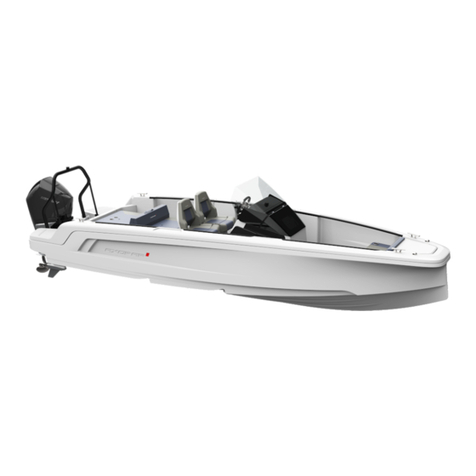
Axopar
Axopar 22 SPYDER owner's manual
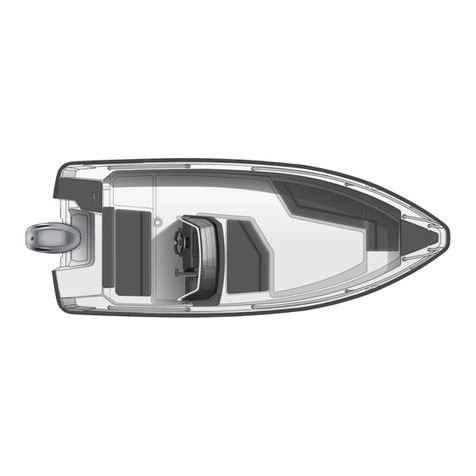
Yamarin Cross
Yamarin Cross 46 Side Console owner's manual
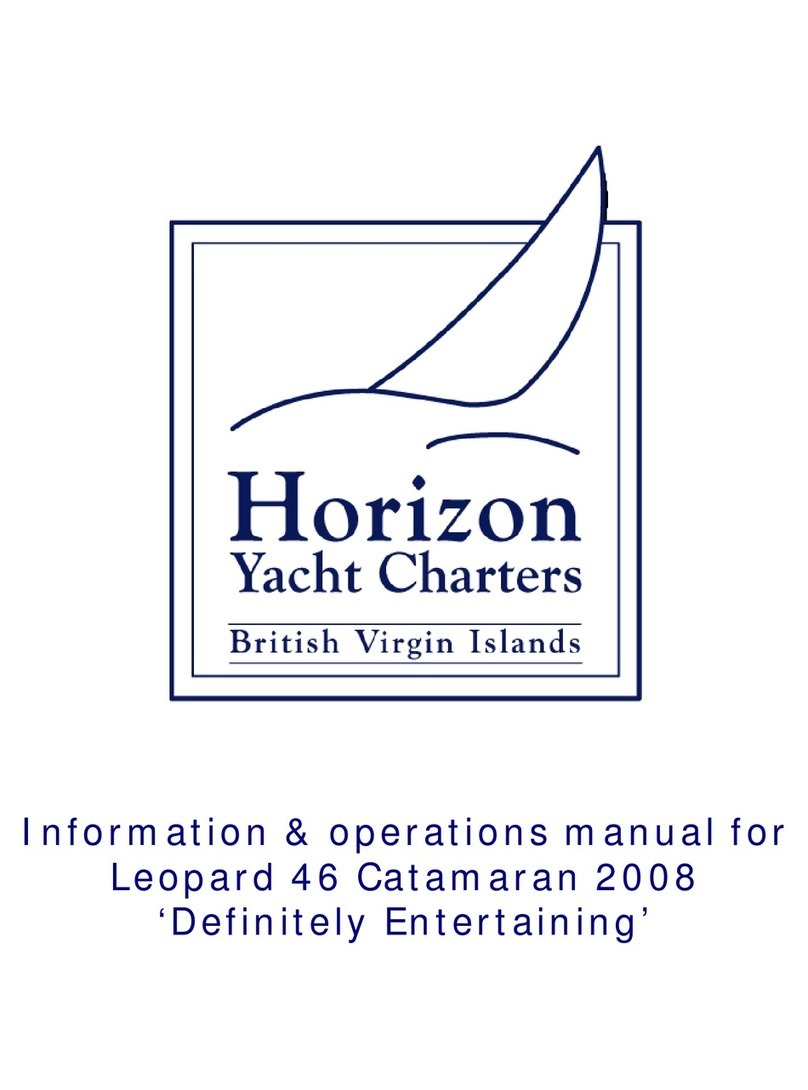
Horizon Yacht Charters
Horizon Yacht Charters Leopard 46 Catamaran 200 Information & operation manual
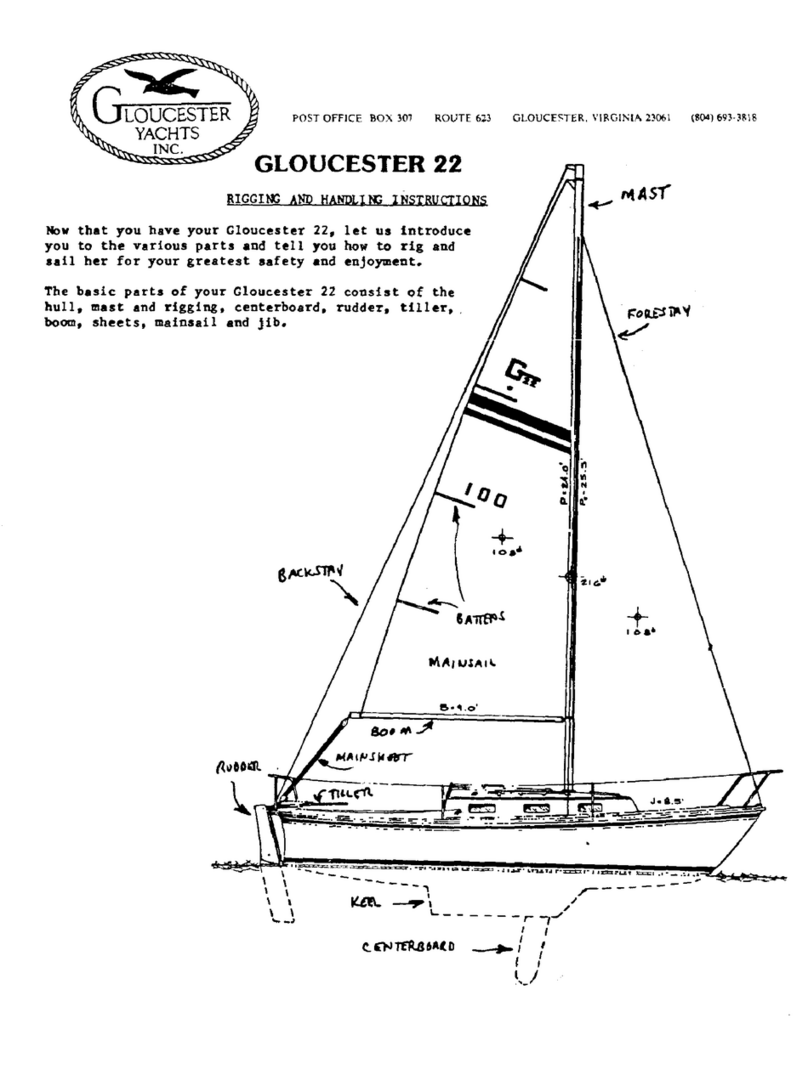
Gloucester Yachts
Gloucester Yachts Gloucester 22 Rigging guide

Sea Eagle Boats
Sea Eagle Boats SE-330 Instruction & owner's manual

Horizon Yacht Charters
Horizon Yacht Charters Bavaria 37 2017 Jitterbug Operation manual
